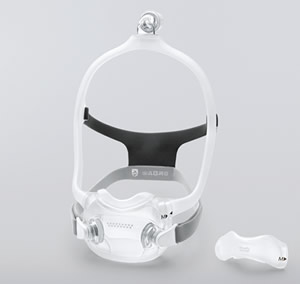Product Spotlight
DreamWear's Three of a Kind
Philips rounds out its line of DreamWear sleep therapy masks with a full-face option, while maintaining an emphasis on patient engagement.
- By David Kopf
- Jun 01, 2018
 When Philips Respironics launched its DreamWear sleep therapy masks, it took a radical departure from traditional sleep mask design, but it was part of an entire product line that aimed to take a “patients first” product design approach. Now Philips is rounding out its DreamWear masks with a much-needed third installment: a full-face version.
When Philips Respironics launched its DreamWear sleep therapy masks, it took a radical departure from traditional sleep mask design, but it was part of an entire product line that aimed to take a “patients first” product design approach. Now Philips is rounding out its DreamWear masks with a much-needed third installment: a full-face version.
The masks are part of the Dream Family of sleep therapy products, which consists of three main elements: the DreamWear masks, the DreamStration PAP device (which comes in various CPAP and BiPAP configurations), and its DreamMapper self-management software.
The DreamWear family of masks take an innovative approach toward comfort in that the mask frame, made of flexible silicone, is hollow and carries the airflow. This approach minimizes the use of tubing and hard plastic and lets the patient change sleep position.
Patient-Centered Design
Philips knew that Obstructive Sleep Apnea patients find masks obtrusive and uncomfortable, which is a nagging problem in ensuring therapy adherence. This is especially true for patients recently diagnosed with OSA. So Philips developed its DreamWear masks using patient feedback to design a sleep therapy interface that addressed the comfort needs of patients, as articulated by patients. In fact, that patient feedback included a massive survey of facial features to ensure the mask would provide a universally comfortable fit.
That has continued with the full-face version of the mask. The third cushion option available for the DreamWear mask is similarly designed based on clinical and patient insights. In this case, the mask provides individuals with sleep apnea who tend to breathe through their mouth the ability to easily switch between cushions and comfortably sleep in any position they want with the hose on top of their head instead of in front of their face.
To help patients and providers, the DreamWear full face leverages the existing DreamWear mask frame to offer a third option. Users can simply swap out whichever interface they prefer. The only difference is that an additional “stabilization strap” is added to the existing mask to ensure the full face cushion remains properly adjusted.
“It’s the completion of the DreamWear family,” says Jim Doty, Senior Director of Marketing in North America for Philips Respironics. “We now have a nasal mask, a pillow mask, and now the full face, all on the same frame. Really, it’s a family of masks that all use an interchangeable frame.
“What sleep labs tell us is that they’re able to start on one mask, and once they get the frame size, they can then just go ahead and replace the cushions as needed,” he continues. “Without having to reinstruct the patient, and teach them how to fit the mask or put it on again. Once you’ve done that initial instruction, it works on an ongoing basis.”
And because the mask uses that same frame, it negates some common full-face complaint: the hose in front of the face, and a hindered field of vision.
“We’ve created a clear field of view,” Doty says. “There’s nothing in front of the patient’s face, or in their eyes and their field of view. To create any sort of claustrophobia.
“We also put the tube on the top, to remove any torque that occurs on the front of the mask,” he adds. “This mask allows you to sleep on your side, or nestled into a pillow.”
In terms of funding, the new mask offers the same resupply opportunities.
“It’s the same exact scenario,” Doty says. “You can replace the cushion, you can replace the headgear, you can replace the frame. It’s the exact same. It works exactly like any other full face masks, from a resupply standpoint.”
End of the Line?
So, does this third installment round out the DreamWear masks? Doty says more innovation could be coming down the line, but the platform is solid.
“We’ll continue to evolve the family,” he says. “I think that we really do have faith in the open design. The top of the head, the connectivity to remove the torque. I mean, I think there are some design themes and elements that patients are responding to. At this point, it becomes, how do you find a cushion, and a cushion type, that most effectively treats the patient and they’re most comfortable with?
“I would say that we will continue to iterate some of the cushion designs,” Doty adds. “But right now, from the standpoint of the frame, it’s where it needs to be.”
DreamWear Full Face
Philips Respironics
(800) 345-6443
www.usa.philips.com
This article originally appeared in the June 2018 issue of HME Business.
About the Author
David Kopf is the Publisher HME Business, DME Pharmacy and Mobility Management magazines. He was Executive Editor of HME Business and DME Pharmacy from 2008 to 2023. Follow him on LinkedIn at linkedin.com/in/dkopf/ and on Twitter at @postacutenews.